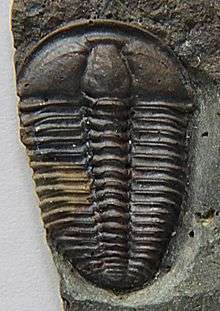Conocoryphe
Conocoryphe is a genus of primarily eyeless trilobites belonging to the family Conocoryphidae. They lived during the Middle Cambrian period, about 505 million years ago. These arthropods lived on the sea bottom (epifaunal) and lived off dead particulate organic matter (a lifestyle called detritivorous).
| Conocoryphe | |
|---|---|
 | |
| Conocoryphe sulzeri, 23mm | |
| Scientific classification | |
| Kingdom: | |
| Phylum: | |
| Class: | |
| Order: | |
| Family: | Conocoryphidae |
| Genus: | Conocoryphe Hawle and Corda 1847 |
| species | |
| Synonyms | |
|
Conocephalus Zenker, 1833, non Thunberg, 1815 (conehead bushcricket), Conocephalites, Couloumania | |
Distribution
Cambrian of the Czech Republic, France, Spain, Turkey, United States (Wisconsin).
Taxonomy
Conocephalites Barrande, 1852, is a disused name for a genus of trilobite, of which the species have now been reassigned to other genera. The name was introduced as a replacement for Conocephalus Zenker, 1833, which was unavailable since Thunberg used it in 1815 for a genus of conehead bushcricket. Barrande however was unaware that Conocoryphe had already been proposed by Hawle and Corda in 1847.[1]
Reassigned species
Some species, that were describe as belonging to Conocoryphe have since been classified in other genera.[1]
- C. kingii = Elrathia kingii
- C. rouayrouxi = Solenopleuropsis rouayrouxi
- C. salteri = Leptoplastides salteri
Description
Conocoryphe is a rather flat trilobite of average size with an elongate oval outline. The overall shape of the headshield (or cephalon) is semicircular. The prominent central raised area of the cephalon (or glabella) is tapering forward, defined by deep axial furrows, and has three pairs of vaguely impressed furrows that are directed backward and inward and do not connect across the midline. The glabella is separated from the anterior margin by a very conspicuous narrow convex preglabellar field that is lower than and does not reach the adjacent cheeks (or genae). To the back of the glabella, the occipital ring is distinct. Without eyes but for one known exception. The eye ridges (when present) are threadlike, evenly curved, extending from the anterior corners of the glabella to the genal angles. The anterior cephalic border furrow is deep, concave and wider than the narrow convex border itself. The lateral cephalic border is divided longitudinally by a suture and is continued into slender, backward-directed genal spines, but this feature is generally not visible. The delicate genal spines extend to the 4th thorax segment, but are often broken off, even in well preserved specimens. The palate (or hypostome) is not connected to the dorsal calcified exoskeleton, a state called natant (or floating). The cephalic doublure and ventral sutures are not known. The articulate midportion of the body (or thorax) consists of 14 segments, with a rather narrow axis (of about 20% of the total width) that evenly tapers backwards, and with deeply furrowed pleurae stretching outward perpendicular to the axis and with truncate extremities. The tailshield (or pygidium has 6 to 8 segments, less well-defined further back, and arching backward. The pygidium is semicircular in outline, its outer margin evenly curved, and it has a narrow, well-defined border. It is about half as wide as the cephalon (micropygous), and about half as long as wide.[1]
Secondary sight
Conocoryphe provides a rare (but not unique) example of secondary eye development. Conocoryphids lack eyes except for Conocoryphe oculata. This species is otherwise very similar to its relatives from the Montagne Noir region in France. C. oculata has normal curving eye ridges, although the dorsal suture is marginal like in its blind family. Due to poor preservation, lenses have not been found. It seems that the expression of a gene for eye development was only suppressed and not lost, and the eye could develop when the suppression lifted.[2]
References
- Moore, R.C. (1959). Arthropoda I - Arthropoda General Features, Proarthropoda, Euarthropoda General Features, Trilobitomorpha. Treatise on Invertebrate Paleontology. Part O. Boulder, Colorado/Lawrence, Kansas: Geological Society of America/University of Kansas Press. pp. O242. ISBN 0-8137-3015-5.
- Whittington, H. B.; et al., eds. (1997). Part O, Revised, Volume 1 – Trilobita – Introduction, Order Agnostida, Order Redlichiida. Treatise on Invertebrate Paleontology.
External links
- Conocoryphe at fossilworks.org
- Conocoryphe at insectoid.info